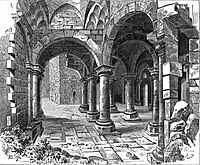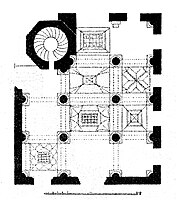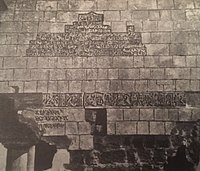مسجد منوشهر - ويكيبيديا
هذه مقالة غير مراجعة. (ديسمبر 2024) |
| مسجد منوشهر | |
|---|---|
 | |
| إحداثيات | 40°30′19″N 43°34′12″E / 40.5052°N 43.5701°E |
| معلومات عامة | |
| الدولة | |
| معلومات أخرى | |
 | |
| تعديل مصدري - تعديل | |
مسجد منوشهر، أو مسجد مانوشهر ( بالكردية : Mizgefta Menûçêhr ) هو مسجد في مدينة آني التي تعود إلى العصور الوسطى في محافظة قارص في تركيا. تم بناؤه بين عامي 1072 و1086[1] من قبل منوشهر بن شاوور من سلالة الشداديين الكردية. بدأت أعمال ترميم المسجد في يونيو 2020.[2][3][4]
التصميم
[عدل]يعتبر أسلوب القبو مشابه لأسلوب القبو الموجود في كنيسة الرسل القديسين في آني (التي بُنيت قبل عام 1217) مما يشير إلى تواريخ وظروف متشابهة على نطاق واسع.[5]
النقوش
[عدل]يوجد نقش كوفي في شريط طويل على واجهته اليسرى يتعلق بتأسيس المسجد على يد منوشهر بن شاوور، في عهد السلطان السلجوقي ملك شاه الأول:[6]
يوجد نقش صغير ثلاثي اللغة في الزاوية اليسرى السفلية يقول:
In Georgian [upper two lines]: In koronikon 458 [1238] I, the atabeg Zakaria, I have confirmed this
In Armenian [lowest line]: Those who observe this, may they be blessed by God» – Trilingual inscripition[7]فوقها يوجد نقش كبير من المغول الإلخانيين يعود تاريخه إلى عام 1319، وهو مرسوم ضريبي.[8][9]
- مسجد منوشهر، مخطط، 1881.[10]
- مسجد منوشهر من الخارج، 1881.[10]
- النقش ثلاثي اللغة
- عمود علوي بتصميم مقرنص
- سقف بنمط المقرنصات، 1072-1086
- ديكورات السقف
- ديكورات السقف
انظر أيضا
[عدل]المصادر
[عدل]- ^ Ani Cultural Landscape (PDF). Unesco. ص. 31. مؤرشف من الأصل (PDF) في 2024-04-04.
Researchers has dated the structure to the year of 1086
- ^ "SHADDADIDS – Encyclopaedia Iranica". iranicaonline.org. اطلع عليه بتاريخ 2020-12-13.
- ^ "Anatolia's 1st Turkish mosque to open to worship after restoration". The Frontier Post (بالإنجليزية الأمريكية). 25 Jun 2020. Retrieved 2021-06-02.
- ^ Kalas، Veronica (2008). "The Georgian Aspects of Medieval Architecture at Ani in the Thirteenth Century: The Church of Tigran Honents and the Mosque of Minuchir". في Tumanishvili، D. (المحرر). Georgian Arts in the Context of European and Asian Cultures. Tbilissi: Georgia Arts and Cultural Center. ص. 211–216. مؤرشف من الأصل في 2024-07-20.
- ^ Eastmond، Antony (1 يناير 2017). Tamta's World: The Life and Encounters of a Medieval Noblewoman from the Middle East to Mongolia. Cambridge University Press. ص. 130, note 15. DOI:10.1017/9781316711774.007.
This date is based on the similarity between its stone vaults and those of the zhamatun of the church of the Holy Apostles, which has a terminus ante quem of 1217, determined by the earliest surviving inscription there: Orbeli, Corpus Inscriptionum Armenicarum, no. 56; Basmadjian, Inscriptions armeniennes d'Ani, no. 49.
- ^ ا ب Eastmond، Antony (1 يناير 2014). "Inscriptions and Authority in Ani". Der Doppeladler. Byznanz und die Seldschuken in Anatolien vom späten 11. bis zum 13. Jahrhundert, eds. Neslihan Austay-Effenberger, Falko Daim: 75-76, Fig.5. مؤرشف من الأصل في 2024-08-11.
- ^ Eastmond، Antony (1 يناير 2014). "Inscriptions and Authority in Ani". Der Doppeladler. Byznanz und die Seldschuken in Anatolien vom späten 11. bis zum 13. Jahrhundert, eds. Neslihan Austay-Effenberger, Falko Daim: 79. مؤرشف من الأصل في 2024-08-11.
- ^ Eastmond، Antony (1 يناير 2014). "Inscriptions and Authority in Ani". Der Doppeladler. Byznanz und die Seldschuken in Anatolien vom späten 11. bis zum 13. Jahrhundert, eds. Neslihan Austay-Effenberger, Falko Daim: 75-76, Fig.5. مؤرشف من الأصل في 2024-08-11.Eastmond, Antony (1 January 2014). "Inscriptions and Authority in Ani". Der Doppeladler. Byznanz und die Seldschuken in Anatolien vom späten 11. bis zum 13. Jahrhundert, eds. Neslihan Austay-Effenberger, Falko Daim: 75-76, Fig.5.
- ^ Kalas، Veronica (2008). "The Georgian Aspects of Medieval Architecture at Ani in the Thirteenth Century: The Church of Tigran Honents and the Mosque of Minuchir". في Tumanishvili، D. (المحرر). Georgian Arts in the Context of European and Asian Cultures. Tbilissi: Georgia Arts and Cultural Center. ص. 211–216. مؤرشف من الأصل في 2024-07-20.Kalas, Veronica (2008). "The Georgian Aspects of Medieval Architecture at Ani in the Thirteenth Century: The Church of Tigran Honents and the Mosque of Minuchir". In Tumanishvili, D. (ed.). Georgian Arts in the Context of European and Asian Cultures. Tbilissi: Georgia Arts and Cultural Center. pp. 211–216.
- ^ ا ب ج Allishar (1881). Shirak. Teghagrut'iwn patkerats'oyts' [Illustrated Topographical Study of Shirak].
- ^ "Armenian Architecture - VirtualANI - The Mosque of Minuchihr". virtualani.org.


 French
French Deutsch
Deutsch









